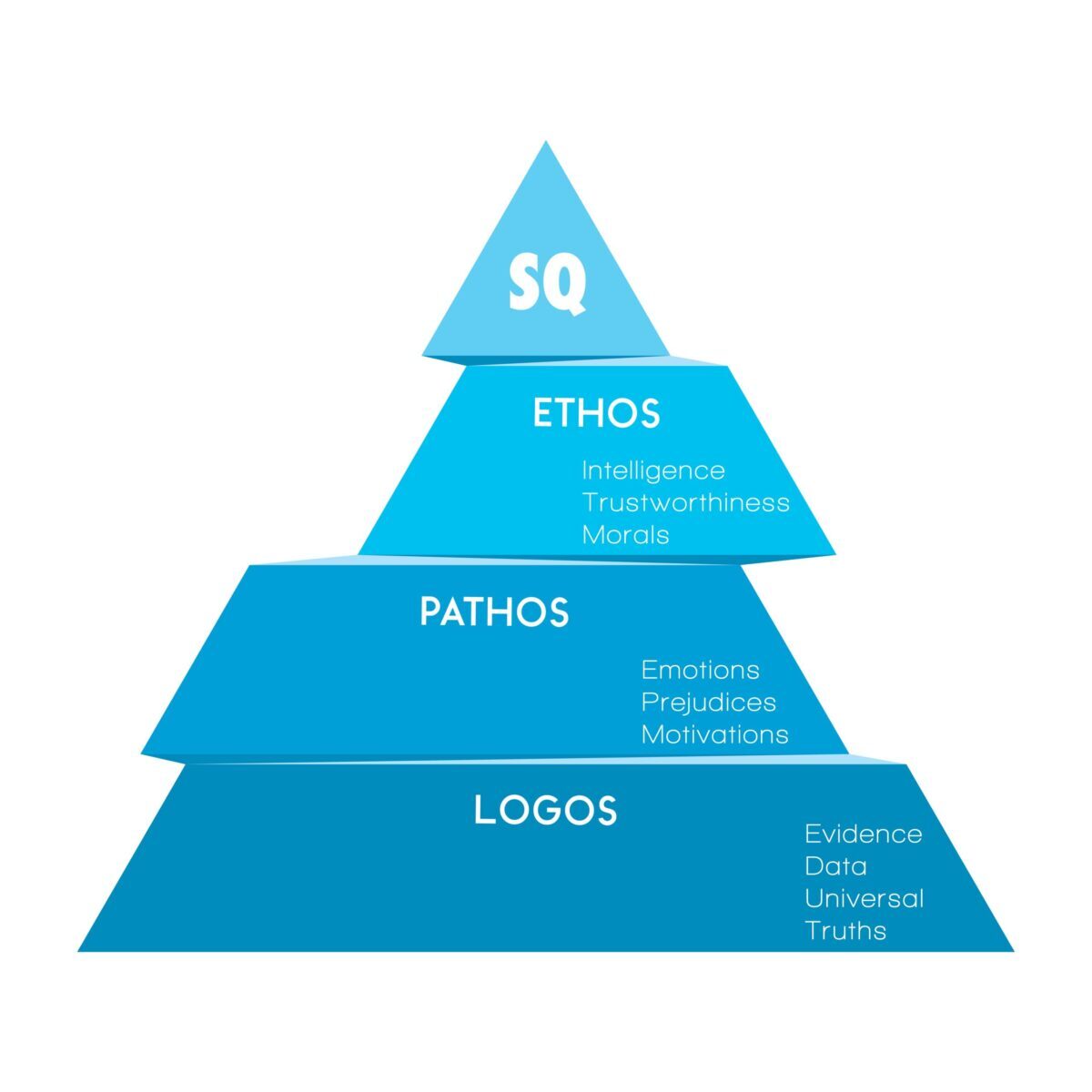You won’t be surprised to learn that, as a writer, I’m fascinated by language. In my role at Fifty Five and Five, I enjoy practising my craft for our clients to achieve the results they need. The writer’s toolbox is a rich and varied one, and the writing team here use all of it to present our clients and their products and services accurately and effectively. Of the many theories and devices of language we use, I’m particularly interested in how we apply concepts of rhetoric in marketing.
The art of effective or persuasive speaking or writing, especially the exploitation of figures of speech and other compositional techniques.
In a nutshell, that’s it. The art of persuasion.
People don’t just use rhetoric in marketing, public speaking and debating. We use it all the time. We speak, we listen, we read, we write – and rhetoric is always there. It’s embedded in all human thought and expression. That’s why much of what I’ll talk about here may not seem new to you – because you’ve already been using rhetoric all your life, without always realising it.
Think of the times in everyday life that you use words to influence and persuade others. In your professional life, in your personal life, in all kinds of situations. Getting out of a parking ticket. Convincing your boss to give you a raise. Talking a friend into meeting at this restaurant, not that one. It all involves rhetoric.
The classical art of persuasion
‘Rhetoric is the faculty of discovering in any particular case all of the available means of persuasion.’ – Aristotle
The classical Greek philosopher Aristotle is known as the ‘father of rhetoric’. He developed a theory of persuasion in the 4th century BCE that’s still every bit as applicable today. Aristotle also wrote Poetics, the world’s earliest known treatise on theories of literature and drama. It’s safe to say he knew a thing or two about the spoken and written word.
According to Aristotle, there are several clearly defined elements of rhetoric. They each work in different ways, appealing to different parts of our thinking and achieving different persuasive effects.
We use all of these kinds of rhetoric in practically everything we write, to varying extents, with varying aims, and in various combinations. You don’t have to keep these in your mind every time you write marketing copy. As I mentioned earlier, it’s likely you already apply them automatically, unconsciously, instinctively, because they’re fundamental to human thought, speech and persuasion. But it’s useful to examine exactly how we commonly use these rhetorical concepts, and how we can use them in future.
What are the elements of rhetoric? Let's take a closer look...
For the classical Greeks scholars, this might have meant knowing the best argument in a philosophical debate. For marketers, it’s a comprehensive marketing strategy. Who is this campaign or asset aimed at: the chief information officer (CIO) or a software developer? Are you trying to gain awareness or are they in the consideration phase of the path to purchase?
Without clear answers to questions like these – a firm sense of telos – your marketing won’t be as effective as it could be. It’s difficult to achieve your aims when you don’t know exactly what they are.
Ethos: promoting your credibility
‘The true orator is the good man speaking well.’ – Quintillian
Trust makes all the difference. Our choices are strongly influenced by whether we have confidence in a person, an organisation, brand, product or service. And this is at the heart of ‘ethos’. Is the speaker ethical? In B2B marketing, that can be taken to mean ‘are they credible’?
When a business promotes their expertise, they draw on ethos. They can be trusted to do a good job, to provide a high standard of service, to bring a superior set of skills and expertise to the table.
‘We have solutions spanning a range of industries and sectors’. Statements like this tap into a feeling of ethos – of being capable and ready to meet clients’ needs. Similarly, when an organisation namechecks their customers, for instance listing them or including their logos on their website, this is a direct appeal to ethos. It says, ‘we have a proven track record of working for successful companies just like yours’.
And how many companies’ marketing talks about the length of their experience? They might mention ‘50 years of satisfied customers’ or that they were ‘established in 1905’. These too, are appeals to ethos; portraying themselves as a solid, trustworthy organization of long standing.
Building a sense of ethos is crucial to successful marketing. All the types of rhetoric can be used to foster this sense of trust, but especially the one I’ll explain next.
Pathos: the appeal to emotion
‘Rhetoric is the art of enchanting the soul.’ – Socrates
Emotion plays a part in everything we write. We’re not robots, or Dr Spock, although certain decisions must rely more on considered logic than instinctual feelings (we’ll come back to that later).
Emotion is what pathos works on, in particular, sentimentality. Consumer-facing marketing leans on this heavily sometimes but, whether in B2B or B2C, evoking positive emotions toward your organization, brand or product is always good for business.
When you create a favourable emotional response, you instantly become much more memorable. That person will then associate you with that feeling, consciously or unconsciously.
This doesn’t have to be evoked via a big, bombastic TV commercial that tugs at the heart strings. Most brands work hard to foster a general sense of likeability, which can be as simple as having pleasant branding and communications; communicating with prospective customers in a clear and enjoyable way. People are people, whether they’re wearing their ‘business hat’ or not: bombarding them with cold jargon and stilted sentences will put them off, while talking to them with warmth will do the opposite.
B2B marketing also often creates this sense of goodwill by producing content: useful, free materials that help customers make their decisions. It would be a mistake to see your content as simply a gated asset created to gain contact details and sales leads – it should be valuable to both you and your prospective customer.
As with all other marketing communications, the same rules apply here; your blogs, infographics, eBooks or whitepapers should be informative, well-written and excellently designed, breaking down dense technical subjects simply and bringing them to life with well-chosen analogies. Your customers will thank (and like) you for it.
Kairos: the right moment in time
‘This is the right time, and this is the right thing.’ – Sir Thomas Moore

Kairos is an often neglected or even forgotten principle of rhetoric, but it shouldn’t be. It refers to time - not in a strictly chronological sense but in terms of good timing. A particular situation or moment. The right place and the right time.
Lead nurturing is kairos in practice – an exercise in timing. Guiding buyers along the purchase journey, being aware of what their thoughts and responses are likely to be at each stage and tailoring your messaging accordingly.
Marketers also know all about creating a sense of urgency. The limited-time offer is a good example of this, and the ‘call to action’, a marketing staple, is a simple and effective embodiment of this use of kairos in marketing: ‘buy now’.
Businesses’ messaging frequently uses evokes urgency - that ‘now’ is the right time to act. Other interpretations of the term kairos are ‘the times’ and 'the weather'. In marketing communications, this could mean the current technological or economic climate or the state of the market. The zeitgeist, a paradigm shift that is underway, a radical sea change in business models.
In the technology world, concepts like digital transformation or the advent of big data and the Internet of Things drive businesses to make new investments and changes urgently, to adopt early and be part of the moment or the movement that is occurring.
It’s a powerful motivator, when used correctly. Nobody likes to be rushed, but nobody wants to miss out, either. Kairos evokes opportunity, and that’s extremely compelling.
Telos: knowing your purpose
‘The two best rules for a system of rhetoric are: first, have something to say; and next, say it.’ - George Emmons
Telos is best summed up like this: having a clear idea of what you’re trying to get across and what you’re trying to achieve. It’s knowing your goal or goals.



Logos: logic, research and facts
‘The duty and office of rhetoric is to apply reason to imagination for the better moving of the will.’ – Francis Bacon
Logos is the appeal to reason. Persuasion through rationality – via facts, statistics and research.
An important rhetoric in marketing, it can strongly evoke others. A persuasive argument that demonstrates experience and expertise can create a feeling of credibility (ethos) and emotional reassurance (pathos).
But a logic-driven approach is powerfully compelling in itself. Particularly in the B2B sphere, where people have a responsibility to make the best and most thought-out decisions possible with company money. In these circumstances, they respond especially well to a highly rational argument. They may have to repeat those same arguments to other stakeholders in their company to justify the spend.
When you provide customers with a logical, fact-based argument for an investment, you’re not only persuading them. You’re helping them to persuade anyone they may answer to. Sometimes that’s just as valuable.
This is where we come back to content - perhaps the essence of logos in business-facing marketing. The more useful your content is, the more persuasive it is. That’s why it’s important that everything is factually correct and technically sound. Make sure you avoid bad research and don’t hesitate to reference reputable third-party sources that support your case, such as whitepapers from market research companies and tech consultancies. Put yourself in the reader’s shoes: ‘would I find this helpful?’ The answer should always be yes.
So now you have a good understanding of what a rhetoric is and how to use it in marketing, try to apply it to your content and see what results you get.
Want to start speaking to leads and customers more effectively?
If you’d like to learn more on perfecting your marketing messages, just contact Fifty Five and Five, or read our case studies to see how we’ve helped other organizations tell their stories.

